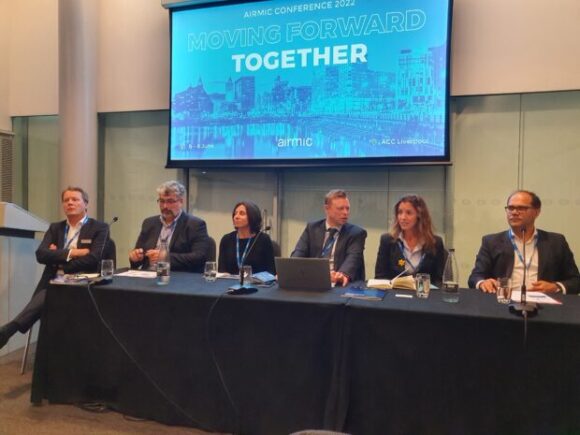While supply chain risks are insurable, many products do not cover non-damage business interruption, and companies could find they aren’t covered for shipping delays that don’t involve physical damage. As a result, many risk experts believe that if insurance isn’t available, then additional holistic solutions need to be found—to prevent losses from occurring in the first place.
Doing nothing is not an option.
A recent survey conducted by the UK risk management association, AIRMIC, found that “supply chain failure” was tied at No. 2 in the top 10 list of significant threats facing businesses (along with “geopolitical risk” and “climate and net zero transition”). The No. 1 threat was “cyber incident, including ransomware attack.”
A separate survey published by the Federation of European Risk Management Associations (FERMA) came to a similar conclusion: “supply chain or distribution failure” was at No. 2 on the list of threats identified by risk managers, after “cyber threats.”
“The biggest threats for businesses in 2022 are linked or amplified by the global pandemic and Ukrainian crisis: cyber threats, supply chain and disruption failure, geopolitical uncertainties, and uncertain economic growth, notably with the increase in raw material, energy costs and the issue of their availability as well as the inflation,” said FERMA in a commentary about its 2022 European Risk Manager Survey.
Interestingly, each of those threats has a supply chain component.
The risk is insurable, but not always. Coverage can be expensive, and therefore proactive risk management is key. Both insureds and their insurers must work together to understand and tame these complicated risks, industry practitioners agree.
(This article first was published in Carrier Management, Insurance Journal’s sister publication. See below for links to other supply chain articles in that issue).
“Insurance is an integral part of managing supply chain risks in the global economy,” said a Swiss Re sigma report published in 2020, titled “De-risking global supply chains: rebalancing to strengthen resilience.”
“A number of insurance solutions can and do facilitate the smooth functioning of business and commercial transactions, both nationally and internationally, including covers for supply-chain disruptions…,” said the report.

While insurers will cover the loss of a critical named, or tier 1, supplier, they don’t generally cover the supplier of the supplier, explained Frederick Gentile, director of Risk Engagement at WTW, in an interview with Carrier Management. Gentile said he has come across some very rare examples where tier 2 suppliers are actually specified in the business interruption policy.
In addition, many property policies will only cover business interruption if there is physical damage from an event, such as a fire, flood or storm damage, he explained. “However, if there’s an industrial action, such as a strike, which causes shipping delays, there is no physical event covered by the policy because there’s no damage.”
However, other insurers do cover losses from non-damage business interruption. For example, Tokio Marine Kiln (TMK) offers a Consequential Loss & Trade Disruption policy, which it has been writing since the 1990s.
The policy typically kicks in after around 30 days, which means that TMK covers the catastrophic delays—six months of disruption—that can affect a business but not the ordinary bumps in the road that occur in the normal course of doing business, said Hugh Selka, underwriter, Special Risks, during a presentation on supply chains at AIRMIC’s 2022 annual conference in Liverpool.

Selka said TMK expects insureds to have certain risk mitigation measures in place before accepting risks—things like multisourcing of supplies, contingency plans to use alternative ports and stockpiling of critical parts, he said.
“If you’ve got two months of supply, then we can happily structure our policies to [trigger] after your two months of stockpile is exhausted, which reduces the cost of insurance.”
The company covers the extra expenses of transporting goods after a delay, the additional costs of sourcing from alternative suppliers, late charges and loss of profits.
Selka recalled a recent claim for late charges of $15,000 a day. “[It] doesn’t sound like very much, but in the end, it was about three months delay. It was really painful, but that’s why we’re there. It’s quite satisfying as an insurer to be able to help clients out in situations like that.”
TMK is currently seeing a lot of interest for its trade disruption product. “There are clients calling up and saying, ‘Can you insure me for delays at Long Beach port? Can you insure me against the war in Ukraine?’ The answer is, ‘no’—because it’s already happened,” he said.
But TMK is open for business to those clients who are thinking more proactively about the risks that their supply chains face, Selka continued.
“We’re open for clients who think about their supply chain in a really constructive and holistic way. And actually, by the time they come to speak to us, they’re probably a long way down that road already.”

Caroline Woolley, director and practice leader UK and Europe at the forensic accountants Meaden & Moore, said insurers may be willing to provide cover for direct suppliers but have to be careful about risk accumulation because they may also be covering the direct supplier as a first insured as well as its direct supplier.
“This accumulation and connectivity of risks is really difficult from an insurance perspective to understand. From a data and analytics perspective, it’s something that insurers have to get their heads around for the risks that they face. But if everyone works together to try and look at that connectivity and the accumulation of risk, then we start to make some progress,” she said during an AIRMIC panel discussion on managing supply chain disruption.
Supply chain risk managers should look at the impact of supply chains on their businesses first, do scenario testing and the risk management piece—and then, of course, the insurance piece hopefully can fit in, she continued.

But Woolley acknowledged that sometimes insurance is expensive, recalling a conversation with a risk manager whose company retains £500 million (over $600 million) via a captive before the external insurance cover kicks in.
Whether or not the risk is insured, insurance does focus a company’s attention to look carefully at supply chain claims, she said, explaining that, in the past, a lot of these losses were swallowed up in operational costs, and the company had to take the attitude, “Well, things happen.”
On the other hand, there will be an impact on the business, even if the losses are not separately identified, Woolley said.
“At least, if it’s insured, people separately identify those events, those issues, those losses, and quantify them. So, that’s one good thing. It is possible to quantify those exposures, and some of them are insurable,” she added.
Woolley noted that the normal rules for business continuity may not apply after a natural catastrophe that causes a wide area damage situation. There might not be any phone signals, Internet, and the ability to rebuild quickly is almost impossible.
“There isn’t availability of alternative premises because it’s happened to everyone—it’s wide-area damage. Who will pay for all the mitigating actions that are in your business continuity plan? If it’s an insured event, hopefully insurance will,” she said. While business interruption is covered with property damage insurance, when developing a BCP, “you still have to think about non-damage events as well.”
Woolley recommended starting with the impact on the business of any major interruption and then looking outside at events to see which of them can be insured.
There are losses going on around the world all the time and supply chain interruptions going on all the time, but it’s important to learn from the successes by looking at the past, looking at the future, linking with business continuity and insurers, she emphasized. “I’m a claims person, so I deal with real losses every day. Don’t wait for a loss to happen before quantifying exposures and checking your policies.”
The big challenge is to try to understand the size of the supply chain problem as well as the financial and reputational impact if the disruptive event occurs, said Tom Teixeira, partner with management consultant Arthur D. Little, who also spoke during the AIRMIC panel discussion on supply chains. “We’re seeing more and more challenges from boards and executive committees to say, ‘Look, we’ve got supply chain risk as one of our key risks.'”
Teixeira noted that he has been involved with a survey of CEOs, post-COVID-19.
He said the surprising finding was that many CEOs were caught off guard by the “velocity” of the supply chain disruptions during COVID. They were surprised by how quickly the problem promulgated throughout the supply chain and affected their businesses.
“No one was ready for what we saw in terms of COVID and the speed at which things changed. Even people in the risk and insurance industry, who had been discussing these risks, didn’t think it would have that kind of a global impact,” Woolley agreed.
After two fires at Japanese semiconductor companies, Adrian Oxley, principal engineer, Semiconductor/Digital at insurer FM Global, said it was “amazing to see” how incidents within the supply chain trickle down to affect many industries and how the supply chain “is so inextricably linked.” He also spoke at the AIRMIC event.
Technological Tools
There is a vital role for technology in providing supply chain risk management and mitigation—for insurers and insureds.
“[Global supply chains] have been honed over decades to focus on efficiency and cost-effectiveness. Of late, with rising trade tensions and the COVID-19 crisis, considerations of resilience and risk management have become more prevalent,” said the Swiss Re sigma report.
“Digital technologies offer a way to better understand the supply chain in terms of risk identification, assessment and monitoring,” said Swiss Re.
“For example, an end-to-end data platform can go a long way to reducing operational risk by ensuring data security and the sharing of critical information with all stakeholders along a supply chain,” the report said.
Examples of technologies used to de-risk the supply chain include low-cost sensor solutions and big data analytics.
Some companies are taking the matter into their own hands by applying their own sensor solutions to track supply chains. One example is the German shipping company, Hapag-Lloyd, which is planning to equip all its containers with real-time Internet of Things (IoT) tracking devices, giving customers full visibility of any container movement.
“The devices will be able to transmit data on a real-time basis from each container and by this make the supply chain more transparent and efficient,” said Hapag-Lloyd in a statement in April 2022. “They can supply location data based on GPS, measure temperature and monitor any sudden shocks to the container.” The project will be completed in 2023.
“[T]he development of digital supply-chain ecosystems is driving new insurance opportunities. They enable the collation of structured and unstructured data, allow on-demand marketplace matchmaking for buyers and sellers, and the establishment of an infrastructure for the delivery of digital products,” Swiss Re.
These will enable insurers to offer risk management- as-a-service in supply-chain risk reduction, Swiss Re said.
***
This article first was published in Carrier Management’s third-quarter magazine, which is focused on supply chain risks. (CM is Insurance Journal’s sister publication).
Related supply chain articles are:
- Pandemic, Supply Chain Challenges Driving Auto Insurers Further Into a Hard Market
- Pay-As-You-Go Cargo MGA Closing Insurance Protection Gap for Smaller Shippers
- Real-Time Tech: Supply Chain Analysis Tools
All of the articles in the magazine are available on the magazine page of CM’s website.
Click the “Download Magazine” button for a free PDF of the entire magazine.
To be able to read and share individual articles more easily, consider becoming a Carrier Management member to unlock everything.
Was this article valuable?
Here are more articles you may enjoy.



 Good Times for US P/C Insurers May Not Last; Auto Challenges Ahead
Good Times for US P/C Insurers May Not Last; Auto Challenges Ahead  Billionaire NFL Owner Suing Over Billboards Near His LA Stadium
Billionaire NFL Owner Suing Over Billboards Near His LA Stadium  Door of Swiss Bar Where 40 Died in Fire Was Locked, Says RTS
Door of Swiss Bar Where 40 Died in Fire Was Locked, Says RTS  10 Highest Class-Action Settlements in 2025 Eclipsed $70B Total: Duane Morris
10 Highest Class-Action Settlements in 2025 Eclipsed $70B Total: Duane Morris 

